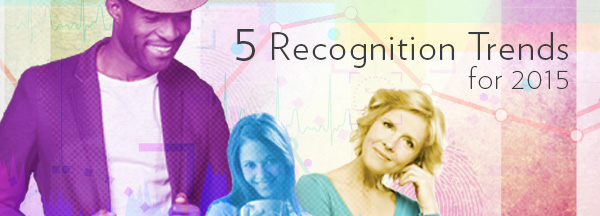
In our 5 Recognition Trends for 2015 eBook, we share our employee recognition insights and what your organization can do to see results. This is the second installment of a five-part blog series that covers each trend and its effect on employee engagement.
Trend No. 2 — The war for talent moves into recognition
We all know the workforce is changing – it’s been the topic of papers, articles and blog posts for a few years now. On average, 10,000 Baby Boomers retire every day and new generations are taking on their positions. Now more than ever organizations need a strategy for retaining critical talent that will help them continue to meet business goals.
The truth is that most organizations are not ready for the aging workforce according to a survey by SHRM. “Gen X and the Millennials are well-educated generations. It’s just that the need for skilled, educated and experienced workers is going up and up,” explains Jennifer Schramm, SHRM’s manager of workplace trends and forecasting. She references a SHRM Foundation report that notes that the population of younger workers with the education and skills to replace Baby Boomers is not large enough—or growing fast enough—to make up for the older generation’s departure. “This is why [employers] will want to hold onto their experienced and skilled older workers as long as they can,” Schramm said.
How can recognition help retain talent?
Employers need to find innovative ways to attract and retain top talent. Today, processes and programs need to engage people across all generations and celebrate their career, performance and social achievements while providing a personalized experience:
Career Recognition: Recognizing your employees’ loyalty, consistency, and daily efforts can reap great rewards. By providing recognition at every stage of the employees’ work life cycle, you can ensure positive growth from the entire workforce.
- Onboarding
Many organizations go to great lengths to recruit and hire the right talent, but often fail when it comes to keeping them. Onboarding goes beyond the typical new-hire activities, such as completing paperwork, establishing work areas and attending orientation. These programs have a better understanding of just how critical the first year is to employee retention and engagement and the unique needs of each generation in the workforce.
- Length-of-Service
When an employment anniversary award is managed effectively, with the right product and meaningful presentation experience, the award becomes an integral part of the overall effort to enhance employee engagement. Rewarding loyalty through a formal program is not only the right thing to do – it’s the smart thing to do.
- Retirement
Organizations shouldn’t underestimate the power of this once-in-a-lifetime event for an employee. Retirees deserve your entire organization’s appreciation, and it shows other employees that their contributions matter.
Performance Recognition:Creating a culture of recognition can set the foundation for employees to thrive and help you achieve your business objectives. Recognizing employees for displaying the right behaviors fosters the environment to continue that great work.
- Wellness
A healthier workforce is a more productive workforce, so it makes sense to encourage wellness and reward healthy lifestyles. This will reduce healthcare costs and absenteeism, all the while improving employee productivity.
- Peer-to-peer
Empowering employees to recognize their peers quickly reinforces positive behaviors and creates a more connected workforce. These engaged connections form a recognition culture — a fabric of the organization woven strong enough to do more and hold more weight.
- Productivity
When employees know that they contribute to company success, they are more likely to become motivated to perform at levels that exceed job expectations. Recognition helps build engagement, which in turn improves performance and results in higher productivity.
Social Recognition:By celebrating and recognizing your employees in new and exciting ways, you can strengthen employee engagement and re-emphasize corporate values. When you connect an employees’ work life with their personal life through recognition, it shows you care.
- Volunteer Initiatives
Employees that volunteer their time or give back to the community are the face of your organization. Appreciating and recognizing employees for the good work they do, even when it’s outside of work, can have an impact on you company’s culture and reputation.
- Social Media
Facebook, Twitter, and other social media outlets connect your employees to hundreds of people and places. The ability for the employee’s to post, tweet and share recognition announcements, like service anniversaries and special award winners, to your corporate social media outlets or internal communication tools show your employees you’re connected.
- eCards
There are all types of life events that call for acknowledgment or recognition - from employee birthdays and anniversaries to marriages and even a death in the family. They don't require points, certificates or any awards, just the ability to let employees recognize and show their support.
Recognition continues to evolve, becoming a more personalized experience that engages people across all generations. Employers need to take an active role in the execution and maintenance of programs - how they are being responded to and making changes - so the programs speak to the unique needs of their people. With the right recognition strategy organizations can positively impact their people and their business goals while winning the war for talent.

